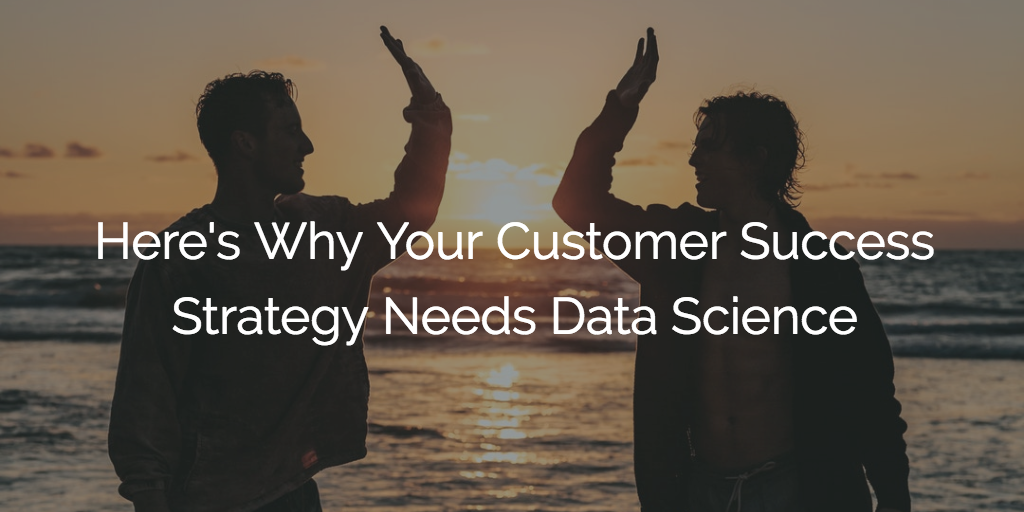All over the world, companies are using data science to cultivate a healthy customer base. However, there are still a lot of questions surrounding this technological advancement.
Let’s go on a quick journey to explore three major components of a holistic data science strategy and how these can improve your Customer Success strategies.
The Limit Does Not Exist…Yet
Look around you. Notice how many of your surroundings are made of plastic. When plastics were first created, it took time for companies to find all of the applications and workflows to accompany its production. At its introduction, plastics were considered an almost magical material that could solve a variety of problems. As time went on, its limitations were identified and the best applications have gone on to be most successful.
Data science has found itself in the same position as plastic. The concept of data science predates computers, but we’re still discovering new ways to apply it. At its simplest, data science is the practice and profession of using statistical tools to answer strategic and tactical business questions. If you don’t work in or closely with the data science space, the term can sound like something out of a science fiction world. While some may think of Terminator, HAL from Odyssey 2001, or Data on Star Trek, the products of data science have very realistic uses and are deeply embedded in our everyday lives. Data science has taken on a metaphysical form in functions like virtual assistants, page algorithms, and predictive scoring.
The emergence of Customer Success in the last decade has provided a new playing field for data science. We’ve discovered new ways to use it to enrich customer data and sustain recurring revenue businesses. With the help of data science, we can segment customers with more detail, predict outcomes sooner, and create personalized experiences at scale. The coolest part is that it’s just the beginning. By familiarizing yourself with the basics and benefits of data science in a CS context, you too can push its limits.
Becoming a Data Science Master
True data science requires mastery of all three elements:
- business acumen to identify the right approach to problems
- statistical acumen to apply tools the problems
- developer acumen to deliver them
This critical overlay of business, statistics, and development drive data science’s universal applicability and market value. Business Analytic Practitioners, Quality Analysts, and Machine Learning Scientists are all forms of data scientists. In order to answer cognitive business questions, these functions need to engage cross-functionally and gather the many data sources that are usually owned or maintained by different teams. Once data is compiled, only then can it be applied strategically and tactically.
If you’re on a Customer Success Operations team—or any Ops team for that matter—your success will be bound by your ability to deliver impactful solutions. But, this can be challenging if your company lacks strong internal alignment across teams. These gaps lead to longer projects with a higher chance of risks and delays. One key thing you can do to ensure success in delivery is understanding your strengths and weakness in the three aforementioned aspects of data science: business, statistical, and developer acumen.
Business Acumen
If you have a weak business acumen, you’re not fully equipped to deliver impactful solutions. No matter how experienced and technical your Data Science team can be, if they are limited in their business acumen, it will be hard to ensure that you are tackling the right problems and can deliver solutions that can be interpreted and actionable.
- Does your team have challenges identifying problem areas in your customer data?
- Is it difficult for your team to come up with ways to solve your problem areas?
If you answered “Yes” to either of these, you need to improve your business acumen.
Statistical Acumen
If your statistical acumen is the weak link, you’ll be limited in the sophistication of the cognitive insights you provide. A lot of companies who work with BI analysts instead of internal dedicated data scientists run into this issue. The more statistically technical your Data Science team is, the more granularity you can provide in your insights. Less strong Data Science teams can’t deliver insights at higher resolutions like region, product, and pricing model pairs. The outputs of projects that are statistically weak run the risk of being unactionable for this reason.
- Do we have enough resources on our team to deliver deep, granular insights (i.e. cognitive analytics tools, machine learning algorithms, Bayesian ensembles, etc.)?
- Are we capable of solving problems with segmentation, prioritization, and prediction?
If you answered “No” to either of these, you need to improve your statistical acumen.
Developer Acumen
If your company has weak development acumen, you won’t be able to fully deliver the programs necessary to solve your business issues. No matter how advanced your statistical or business acumen is, the delivery of those insights or solutions will require manual effort to get the data to refresh the analysis periodically.
- Are we able to integrate and perform all necessary transformations to get the data we need to analyze, build models and implement automated solutions across the business?
If you answered “No,” you need to improve your developer acumen.
Making a Strong Case for Data Science in Your Customer Success Organization
With so much data at our fingertips, a lot of businesses find themselves suffering from an information overload. Data science helps make sense of it all. Just like the way your brain turns disparate, stored information into cohesive thoughts and memories, the same can be said for data science. Whenever you have a memory, those mental images and feelings are simply a connection of firing neurons. Every true insight uncovered using data science is a collection of information derived from the connection of many individual data points. For example, if you want to know which of your products have the highest potential ARR, that insight would be based on information in product/forecast reports and presentations that were built using the data in your data architecture.
Delivering true Customer Success requires proper segmentation of customers, great alignment of business processes, and the ability to deliver customer outcomes. The art of delivering personalized experiences at scale throughout the customer lifecycle is in the science predicting the behaviors that facilitate positive outcomes. In order to improve the data science strategies that will impact Customer Success, you first need to know where you currently stand. How would you define the maturity of your data science strategy?
- Reactive: Conduct exploratory analysis to find the drivers of behavior
- Informed: Conduct descriptive analysis to find primary leading indicators
- Proactive: Conduct prescriptive analysis to find what actions can be taken change outcomes
- Predictive: Conduct cognitive analysis to answer questions of what will happen and why
Once you are aware of your maturity level, the problems you need to solve, and the investments that need to be made in your data science acumen, you can go to your C-suite. When speaking, be sure to convey the focus and how that ties to outcomes over the next four quarters. If you need to improve your business acumen, speak to the need for more impactful actions. If you need to improve your statistical acumen, speak to the need for more sophistication. If you need to improve your developer acumen, speak to the need for more automation.
Paint a picture for your C-suite by tying your data science investments to specific company metrics. Let’s say you want to move from the Reactive to the Informed stage. This requires you to expand your data sources to enable a more proactive approach. You know that this requires you to perform exploratory analysis on new sources and integrate them into your business process. But, relating this to a salient metric, like churn, will make a much more impactful argument. You should be able to get that procurement request fulfilled in no time.
Take the Next Step
Now you know why data science is important, the different types of acumen required to deliver data science solutions, and how to convince C-Suite to invest in your effort. It’s time to take the next step by conducting an internal assessment of the sources you currently have available. Which of the three acumen are you strong in? Which ones are your weaknesses? Take our Maturity Model assessment test to see where your current Customer Success maturity stands against world-class organizations. Use your results as a jumping off point to figure out how you can strengthen your business, statistical, and development skills and what data sources are required to do so. If you need some inspiration, check out my previous blog post on types of data sources, “Data Science Foundations: Defining Primary Data Types.”
As always, I’m happy to talk to fellow data enthusiasts! If you have any questions or would like to learn more about the data science services we provide at Gainsight, I encourage you to reach out at scummings@gainsight.com
.

